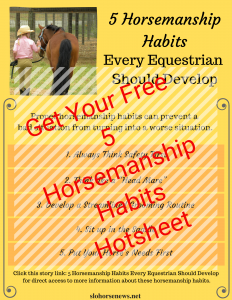Being an equestrian means horse interaction and riding are part of your weekly if not daily routine. Proper horsemanship habits can mean the difference between a bad situation and a worse one. Horses are sensitive and powerful creatures who need a special type of attention and skill to ensure the safety of horse and handler.
Things can get pretty crazy quickly and you can find yourself at the end of a lead rope with a horse leaping or on the back of a horse bolting. What horsemanship habits should every equestrian develop?
What are the 5 Horsemanship Habits you should develop? Get your FREE Checklist to help you develop good horsemanship habits.
5 Horsemanship Habits Every Equestrian Should Develop
1. Always Think Safety First
Don’t drop your guard for even a moment around horses. Even the most trusted horse can spin from a plastic bag picked up from the wind, get excited by a loose horse, or be set off balance by a rider . . . or react to a myriad of other actions.
On the Ground
Always use the safest practices when collecting a horse from a stall or pasture, leading, and grooming.
With Your Tack
Be sure your tack is in the best possible condition. Replace worn straps and buckles. Check the stitching on reins and girths or cinches. Be sure all rivets are tight and won’t burst open with pressure.
As You Ride
Always wear boots when working with horses. When riding, be sure your boots have heels to help prevent your foot from going through the stirrup in the case of an unplanned dismount. A helmet is also a key accessory to consider, as you have only one head.
When you Travel with Your Horse
Get into the habit of doing a truck and trailer trip pre-check before EVERY trip, even if you are just going across town.
2. Think like a “Head Mare”
Horses are looking for a calm, attentive, and responsive leader. Equestrians need to be relaxed and work with clarity so horses will naturally follow in the same manner.
Horse herd mentality plays a key role in how our reactions influence our horse’s reactions. If we remain calm, our horse will calm down easier and quicker. Horses naturally follow the leader, whether human or horse. Experienced horse handlers develop the art of thinking like a head mare in an emergency. Staying calm, as the head mare, will translate to your horse’s reaction.
Go slow when introducing new things to horses. Be sure to introduce items on all sides (up and down, left and right, in front and behind) of the horse and lead a horse through a new concept going in both directions.
3. Develop a Streamlined Grooming Routine
Grooming and tacking up your horse are two activities that must take place before you enjoy a ride. Developing a streamlined grooming and tacking up routine will not only get you on faster, it will also allow you to be a welcome riding buddy. No one like waiting around for that one person to get their horse ready for the ride.
4. Sit up in the Saddle

No slouching or rounded shoulders! Sitting up doesn’t mean stick straight it means your balance is in line with the horse’s motion.
Staying in balance and with the motion of your horse is key to effective riding. The ability to stay with the motion, whether to assist your horse to perform at its best or to simply stay in the saddle when your horse spooks, defines the riders from the passengers. Two things to think about when riding are: Look up and heels down.
One of the best tools for developing a balanced seat is to be lunged while on the horse. This allows the rider to release the hands, and drop the stirrups while someone controls the horse on the lunge.
5. Put Your Horse’s Needs First
Your horse depends on you to provide for his basic needs of feed, water and shelter. This concept was drilled into us as Pony Clubbers. At camp or rallies we were not released to have a meal, or enjoy free time, if our horse’s needs were not tended to first. Put your horse’s needs above your own needs.
What horsemanship habits are you working on?
Have you been challenged by any of these horsemanship habits? What horsemanship habits are you working on to become a better horseman? Let us know in the comments below.
Photo credit: Sharon Jantzen Photos
Need a reminder of the horsemanship habits you should develop? Here’s a hotsheet with each one listed. Download this hotsheet to your device and click the story link at the bottom to have all this information at your fingertips. You will become a member of our SLO Horse News herd where we’ll continue to add horsemanship stories and more to our website. Don’t worry if you are already a member, you won’t get duplicate mailings. Get your 5 Horsemanship Habits Hot Sheet here >.





